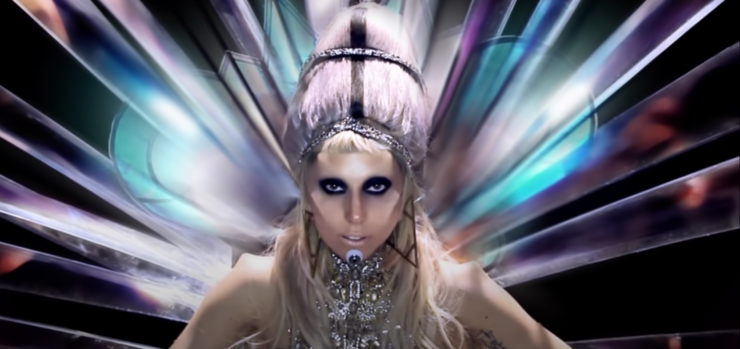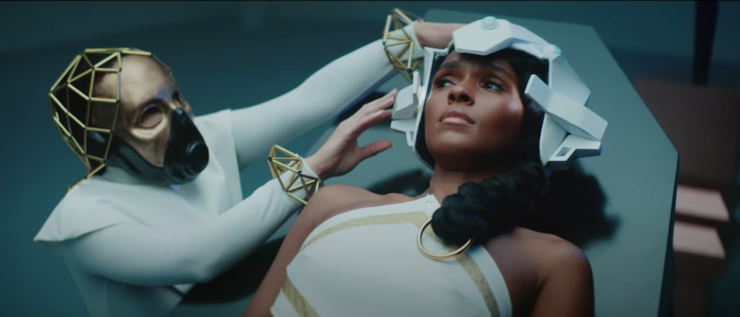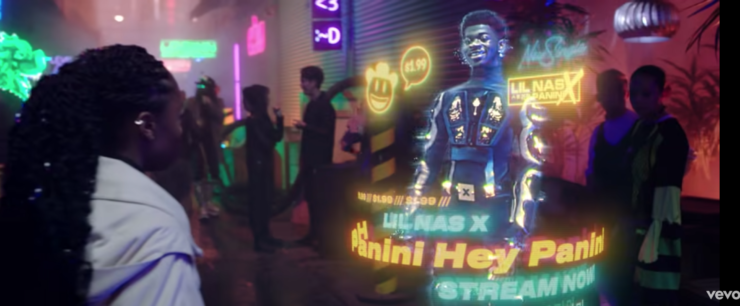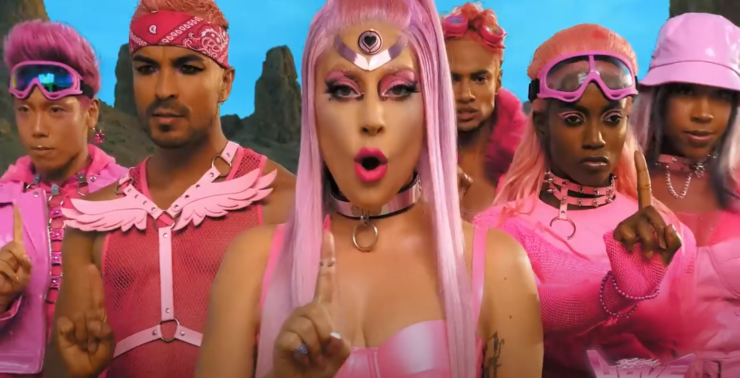The world rots in conflict. Many tribes battle for dominance. While the Spiritual ones pray and sleep for peace, the Kindness punks fight for Chromatica…
Against a desolate landscape, five factions come together to fight. Each group represented by a signature color, they carry weapons and scream at each other in attempts to intimidate. But a new collective enters the battle, dressed in bright pink, carrying a message of hope and joy.
Lead by Lady Gaga, her third eye open, the Kindness Punks are here to fight for love.
It isn’t new to say that Lady Gaga is a queer icon, though for the life of me I can’t remember where it started. It very well could have been immediate—after all, her debut single “Just Dance” is a certified banger, and was played extensively on radios, and in bars and clubs during the year of its release. Her career has always been for lack of a better phrase, gay as hell.
It may have started a long time ago, way before we ever knew her: our favorite former theater kid had a hate group dedicated to her, created by fellow students at her high school. Extreme bullying is an almost universal queer experience, the vicious targeting done by our peers is both damaging and formative. Years later, the now-famous Gaga was hit by another wave of bullying, this time from the Internet, with the incredibly transphobic assertion that Gaga actually had a penis, and was in fact, a man in a wig. Gaga responded not only by saying “Maybe I do…would it be so terrible?…Why the hell am I going to waste my time and give a press release about whether or not I have a penis? My fans don’t care and neither do I,” but by also flashing a cheeky strap-on during her performance at Glastonbury.
It’s easy to see why a person like that would craft a powerful pop persona with giant wigs, outfits made of sequins and leather and titty rockets and meat—and that famous meat dress was, she later mentioned, a commentary on Don’t Ask Don’t Tell. She attended that awards ceremony with several former military servicepeople, who had been discharged for being queer. Her fashion statements have included nods to queer icons like Bowie, Prince, Madonna, and more. She stepped into the role of the young ingenue in A Star Is Born, a part previously played by queer beloveds Barbara Streisand and Judy Garland, cementing herself amongst the greats. It’s her way of saying: I can do anything I want to, and you’re going to watch me while I do it, suckers. And while not all queers are, shall we say, dramatiqué, there is a history of queer populations fighting through the power of glitter and lipstick. It is perhaps this, more than anything, that we cling to—Gaga is a Fuck You in towering ten inch heels.
In a lot of ways, Gaga gives us fantasy. Or, at least, an incredibly heightened reality.
More than anything, Gaga’s presence has always been about hope, joy, and inclusion, specifically geared toward the queer community. And it isn’t an empty promise – Gaga herself is bisexual, and has been open about that since the very beginning, creating a contrast between herself and other popstars the queer community adopts. She’s worked hard to create music, concert spaces, and visuals that make her Little Monsters feel safe and seen. Her efforts have been radical: in 2009, she attended a protest against Don’t Ask Don’t Tell, and put a major spotlight on the issue. She’s worked extensively with New York’s Ali Forney Center for homeless LGBTQ+ youth. In 2019, she told the crowd at NYC’s Pride Parade, “I would take a bullet for you any day of the week.” These messages have often been screamed: those lungs, that voice, carry.
As we enter into the era of Chromatica, we’re looking at over ten years of Lady Gaga’s radical queer hopepunk. The world she has created is one where struggles, differences, and anxieties are met with joy and dancing.
The video for “Stupid Love” is undoubtedly influenced by science-fiction, looking equal parts Mad Max and Barbarella. Gaga, dressed in iridescent pinks, outfitted with reflective makeup, an Alien-esque helmet paired with a pink satin corset, a metallic bodysuit with exaggerated shoulders, leads a pack of diverse dancers as she sings a simple refrain: “All I ever wanted was love. I want your stupid love, love.” And the bold colors of each faction come together, which is….not super subtle symbolism. The message is both simple and effective: Gaga presents us with a future in which there is love, color, crystals, and a bangin’ soundtrack.

But this isn’t the first time we’ve seen Gaga interact with genre—and I’ll argue that Gaga’s entire existence is genre. The video for “Born This Way”, a queer anthem for the ages, begins with Gaga’s face augmented with prosthetics: you may remember her appearing this way several times during that era, with sharp Malificent-esque cheekbones and raised bumps on her forehead. The VoiceOver says:
“This is the manifesto of Mother Monster. On Got, a government-owned alien territory in space, a birth of magnificent and magical proportions took place. But the birth was not finite, it was infinite. As the wombs numbered, and the mitosis of the future began, it was perceived that this infamous moment in life is not temporal, it is eternal. And thus began the beginning of a new race, a race within the race of humanity, a race which bears no prejudice, no judgement, but boundless freedom.”
Is Gaga our mom? Yes. Is Gaga God? Also yes. Gaga establishes herself as Mother Monster to all who feel alienated, othered and not of this world. It’s more than just being marginalized. In this moment, she likens difference to extra-humanity, something greater than. Those she cares for are meant for more than this planet has to offer, meant for the stars and futures beyond. It is intense, sexy, sometimes grotesque, and always beautiful.
In the video for “You & I”, she appears as a mermaid with prosthetic facial gills, as the most fashionable Frankenstien’s monster, and as a beautiful android. And then she sings a love song and kisses herself, appearing in drag as Jo Calderone. In “Bad Romance”, she appears in a cylindrical sculpture dress dubbed The Orbit, meant to signify her as the center of all things moving in the universe. In “Edge of Glory”, she struts down a New York City street in vintage Versace, bathed in neon pinks and blues and purples. This isn’t particularly sci-fi, I just wanted to mention the bisexual lighting.
Gaga’s world has always been futurist and hopepunk, radical and unrelenting and sometimes even vicious about its joy, but it is a specifically queer hopepunk. She is a starlet bathed in rainbows. She is, in a lot of ways, a drag performer. She is giving the gays what they want.
Schitt’s Creek creator Dan Levy has spoken openly about the desire to create a world in which homophobia doesn’t exist, saying “we show love and tolerance. If you put something like that out of the equation, you’re saying that doesn’t exist and shouldn’t exist,” and has seen a lot of success in doing so. Queer creators have, over and over again, presented us with media that reflects the queer experience as best we can manage, and we’re starting to see a lot more work with a Levy-like attitude. After years and years of creators killing their gays, focusing solely on AIDS-related deaths and heartbreak, showing queer kids kicked out of homes by their parents, being beaten by homophobes, and generally using queer narratives to invoke pain and suffering, we’re, frankly, fucking tired. It’s nice to dream of better futures. And so we turn to hopepunk.
I will let my dearheart Alex Rowland explain:
“Hopepunk says that kindness and softness doesn’t equal weakness, and that in this world of brutal cynicism and nihilism, being kind is a political act. An act of rebellion.
Hopepunk says that genuinely and sincerely caring about something, anything, requires bravery and strength. Hopepunk isn’t ever about submission or acceptance: It’s about standing up and fighting for what you believe in. It’s about standing up for other people. It’s about DEMANDING a better, kinder world, and truly believing that we can get there if we care about each other as hard as we possibly can, with every drop of power in our little hearts.”
Hopepunk has to go beyond a hopeful, happy ending—instead we must think of hope as a weapon, as a radical tool against oppression and totalitarianism. In the hands of young people, hope is a blinding light in the darkness. For queer creators like Gaga, hopepunk ideology becomes narrative fuel, a vehicle through which to be loud, proud, and unapologetic in working towards a future filled with joy, love, and dancing. And she works alongside other queer creators in doing so, effectively creating a queer hopepunk canon.
* * *

Like Gaga, Janelle Monae is no stranger to using sci-fi visuals to accompany her music. She has famously referenced the 1927 film Metropolis in many forms over the years, appearing as her alternate self, the android Cindi Mayweather. The hourlong “emotion picture” Dirty Computer, a visual to accompany her album of the same name, features Monae in a dystopia: a body arrives on a floating white block, escorted by masked attendants. Monae, laying on the block, is brought to a blank room and attached to a machine via a white, architectural helmet. Behind glass, two men control the Dirty Computer cleaning process with complex screens that will access her memories. The voiceover sets the scene:
“They started calling us computers. People began vanishing, and the cleaning began. You were dirty if you looked different. You were dirty if you refused to live the way they dictated. You were dirty if you showed any form of opposition at all. And if you were dirty, it was only a matter of time…”
Dirty Computer was something of a turning point for Monae—during the months of promotion, Monae not only came out as queer, but as a “free-ass motherfucker”, and wore a rainbow dress to the BET Awards. She was also meant to heading New York City Pride in 2020. The album is a protest album, an album that is “young, Black, wild, and free”. Lyrics make references to pussy-grabbing, birth control, and police brutality. To Rolling Stone, she said: “I want young girls, young boys, nonbinary, gay, straight, queer people who are having a hard time dealing with their sexuality, dealing with feeling ostracized or bullied for just being their unique selves, to know that I see you. This album is for you. Be proud.”
Over the course of a series of connected music videos, Monae presents an image of the future that features carefree black and brown people dancing at parties. Janelle wears her signature black and white, with rainbow eye makeup. The god-like figure of Tessa Thompson appears in all white, shaving heads of party goers, an anointment. Monae and friends throw an underground protest party, the vibe of which invokes visuals from 1979’s cult classic The Warriors, Whitney Houston, Janet Jackson. She dances in the now famous vagina pants, and sings the praises of her partner’s anatomy over a variety of suggestive imagery. Monae dances with and kisses people of multiple genders, bathed in bisexual lighting. There are celebrations of natural hair, joyful Black bodies, queer love, friendship. Lyrics proclaim: “we don’t need another ruler, all of my friends are kings / I am not America’s nightmare, I am the American dream”. After each track, we see Monae back at the lab, The House of the New Dawn, her memories being deleted. Each of these memories and songs are the things that make her unique and free; they are her identity. But to those in control, they are a virus to be deleted and cleansed from the system. Monae makes a clear path here: identity = freedom, assimilation = destruction. It matters that the two men doing the deleting are white. It matters that her attendant at the House is Tessa Thompson, Monae’s real-life partner at the time, who later helps her escape.
Dirty Computer is a progression of the narrative Monae’s career has been telling for years, only now she is presenting herself as fully human in a dystopian setting where Black, queer love is the key to saving the world. It calls into mind familiar “young people vs. the system” narratives like Divergent or The Hunger Games, with visuals that are equal parts Blade Runner, Eternal Sunshine of the Spotless Mind, and Prince.
* * *

Though his body of work is still new and limited in comparison, queer artist Lil Nas X has created a series of videos that lean on sci-fi visuals. Let us not forget that the iconic “Old Town Road” is a time travel narrative. I know you’re going to argue that it’s a western, and it is, but hear me out—Lil Nas X and Billy Ray Cyrus start in a traditional western that “aint too kind to outsiders”, and then travel through a tunnel to a modern world. In “Rodeo,” he appears as a vampire, equal parts Blade and Twilight. The video for “Panini”—a song with a hater-banishing hook that goes “ayy, Panini, don’t you be a meanie/thought you wanted me to go up/why you tryna keep me teeny?”—is heavily influenced by Blade Runner’s dystopian aesthetics, complete with 3D neon advertisements pushing both products and the slogan “The Future is Yours”. Lil Nas X dances alongside robots and chases the aforementioned ‘meanie’ on a jetpack, and the video ends with the artist changing the familiar neon slogans into blossoms and trees, offering a beautiful, hopeful path forward towards kindness.
* * *
These three artists use sci-fi visual cues along with hopeful lyrics and dancing to show a future of positivity and joy, created by and for queer people. Gaga, Monae, and Lil Nas X are part of what I’ll call the queer hopepunk canon. If we look at the videos for Gaga’s “Stupid Love” & “Born This Way”, Lil Nas X’s “Panini”, and Janelle Monae’s “Dirty Computer” Emotion Picture, we can start to see similar narratives being built: the protagonist exists in a world of darkness and despair, where the system is working against them. Because of who they are, their innate identity, they are being oppressed, teased, erased—whatever the case may be, these artist make it clear that the world isn’t kind to them. But there is a future beyond that promises joy and acceptance for all. Through the power of song, and dance, they are lifted into a place beyond, a dimension of light and love. All three of these artist use their voices to advocate for the freedom of queer people.
These narratives center radical queer ideologies. By presenting queer bodies and voices as the conduit through which a positive future is achieved, and subsequently celebrated, it is as if queer artists are singing this hopeful futurism into existence and bringing us, as viewers, along with them. If we sing loud enough through the pain, if we hold each other’s hands and dance, we can get there together.
Gaga, Monae, and Lil Nas X take us by the hand and say, ‘come with me, you will be safe, you will be loved for exactly who you are. Let’s dance’.
It’s a narrative that queer folks are dying to hear. And like, yeah, for as far as we’ve come, it’s kind of a bummer that we have to think about this as the future instead of as the now. It sucks that we have to keep working towards something that we shouldn’t have to fucking work towards at all. I’m tired, friends. Like….I mean. Y’all know. I don’t wanna get into it. But part of the reason why these narrative arcs hit so deeply with queer audiences is because there’s a historical need for joy and acceptance. I don’t need to tell you that not everyone finds that in real life, and that often we turn to fictional realities to feel like there’s somewhere better for us, somewhere we’re meant to be. It’s a common trope in sci-fi and fantasy: a man leaves the desolate earth behind in search of a strange new world. A girl opens a door to find a place of magic, where she is queen. A knight fights with honor to push back the darkness and free the kingdom of evil. And so is the narrative of queer life—we escape shitty circumstances to find a chosen family, a place where there is love and positivity forevermore.
As queer academic and theorist José Esteban Muñoz says in his text, Cruising Utopia: The Then and There of Queer Futurity:
“Queerness is not yet here. Queerness is an ideality. Put another way, we are not yet queer. We may never touch queerness, but we can feel it as the warm illumination of a horizon imbued with potentiality. We have never been queer, yet queerness exists for us as an ideality that can be distilled from the past and used to imagine a future. The future is queerness’s domain… queerness is essentially about the rejection of a here and now and an insistence on potentiality for another world”.
These artists become the portal, in a way, of our queer fantasies. Through visual storytelling, we are able to glimpse the radically queer hopepunk future of our dreams.
In her newest release, “Rain on Me”, Gaga appears alongside Ariana Grande, another queer pop icon, singing the lyrics: “I’d rather be dry, but at least I’m alive”. The two women dance in front of a futuristic cityscape, and in similar fashion to “Stupid Love”, dance with a group of joyful friends dressed in latex and leather—this time, the color palette is soft pink, lavender, and blue—unmistakably bisexual. In an Instagram post leading up to the video’s release, Grande writes, “one time…I met a woman who knew pain the same way I did…who cried as much as I did….she then held my hand and invited me into the beautiful world of chromatic and together, we got to express how beautiful and healing it feels to mothafuckinnnn cry!”
If that isn’t hopepunk, I don’t know what is.
Christina Orlando is the Books Editor for Tor.com, where they get to be a book nerd all day. As a freelance writer covering poetry, gender, and sexuality, their work has appeared Electric Literature, gal-dem, THEM, Adroit Journal, and Book Riot. They are the winner of Spotify’s 2019 Sound Up grant for people of color in podcasting. Find them on Twitter at @cxorlando










